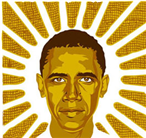Let's allow Ed Morrissey from Hotair.com to educate us on HealthCare.
The Census Bureau released its annual income, poverty, and health insurance survey (2008) yesterday, giving both sides new numbers to use in the health-care debate. ObamaCare advocates can claim that the number of uninsured rose in the year, which it did, from 45.6 million in 2007 to 46.3 million in 2008. Opponents of the administration’s efforts can point to the increased numbers of Americans covered by insurance (255.1 million, up from 253.7 million in 2007) and the wider coverage of existing government programs — which increased by almost 5 million to 87.4 million people in 2008.
The focus will fall on the breakdown of the uninsured. What comprised the 46,340,000 uninsured, according to the Census Bureau?
35.2 million are in families, and 10.7 million are single
21.3 million are white, 14.6 million Hispanic, and 7.2 million black
Just over 30 million are between 25 and 64 years of age, while 7.3 million are children
Almost all of them are in major metropolitan areas (39.2 million)
17.8 million make more than $50,000 a year in annual household income
10.7 million did not work in the past year
Of particular interest is the citizenship/resident category. Foreign-born residents comprise 12.3 million of the uninsured, with only 2.8 million of those naturalized citizens. That leaves 9.5 million non-citizens in the count. The Census Bureau refuses to categorize on their legal residency status, which means that legal and illegal immigrants get counted in this total. Last year, estimates put the number of illegal aliens in this category as 5.6 million out of a total of 9.7 million. Even if we attribute the entire 200K reduction in this category to illegal immigrants leaving the US (as opposed to legal immigrants leaving or illegal immigrants getting insured), it still leaves 5.4 million illegals as part of the overall uninsured number.
In reviewing this data, we can strike off the 17.8 million who made more than $50,000 a year, which is just about the 2008 median income ($50,303). These are people who make enough to buy insurance; while they may have other reasons, such as pre-existing conditions, preventing their purchase, by and large they can at least afford to buy insurance, even if it means making a choice to skip buying something else. The 5.4 million remaining illegal immigrants can also get stricken from the list, as Barack Obama insists that he doesn’t want to provide coverage for them in his overhaul. That brings the number of uninsured down to half, at 23.2 million people.
Next, we have the problem of Medicaid/CHIP underreporting on the ASEC, covered in some detail in Appendix C of the report. Last year, the Census Bureau reported that they missed 2.8 million enrollees in Medicaid. That would bring the number down to 20.4 million uninsured, which comes close to the sum of those who didn’t work at all last year (10.7 million) and uncovered children (7.3 million), although some of the latter overlap with the underreporting of Medicaid/CHIP. The general scope of the problem is between 17 and 20 million uninsured at worst, not 46 million or 30 million, as Obama tried to argue on Wednesday.
Finally, let’s address the canard of “14,000 people lose their health insurance every day.“ The number of people insured rose over the course of the year, by over a million, and those covered by government programs rose by almost 5 million. If 14,000 people lose their health insurance every day, it would amount to 5 million more uninsured for the year. Nothing in the new data gives that indication, and in fact shows that more people find health insurance now than lose it.
The numbers for 2009 won’t look as good, thanks to the massive job losses seen all year. We’ve lost more than 3 million jobs, which probably means many of those have lost their health insurance. Unfortunately, Obama’s plan to overhaul the health-care industry will steal capital from the markets that would create new jobs and provide coverage for those unemployed.
Addendum: While perusing this data, be sure to read the data on poverty. Expect to hear about this year’s increase in poverty to 10.3% of all American families, but it’s interesting to see the historical data on this. According to the data, with the exception of 2003-4, the Bush years were a boon. Except for those two years, the poverty rate stayed below 10% for all of Bush’s term. In contrast, those numbers only went below 10% for two of the Clinton years, 1999 and 2000, which was the best year on poverty the US has had since records began being collated in 1959.
Also, compare the numbers on household types for those same years. Two-parent households did a much better job of staying out of poverty than single-parent homes.
Friday, September 11, 2009
Subscribe to:
Post Comments (Atom)












No comments:
Post a Comment